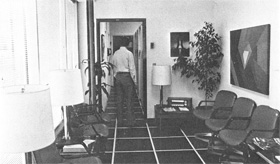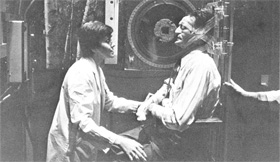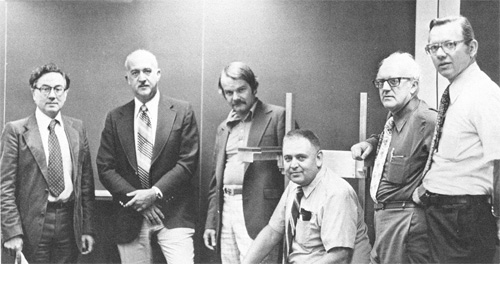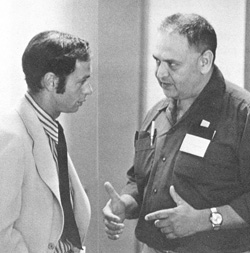CTF Celebrates First Anniversary
Fermilab's Cancer Therapy Facility is one year old this month.
The first volunteer, a tongue cancer victim, was treated Sept. 7, 1976. Since then, a significant number of patients have completed treatment; many pilot studies have been concluded; and a second federal grant for operating expenses has been received.
CTF researchers seek the answer to the question: "Are neutrons better than X-rays in treating some types of cancer?" From first-year results, the answer seems to be a qualified "yes," according to Lionel Cohen, M.D., CTF head and head of the radiation therapy department at Chicago's Michael Reese Hospital. He reports these patient statistics:
120 patients referred by cooperating physicians.
96 patients entered the CTF program.
85 patients completed treatment.
18 patients were considered unsuitable for treatment.
11 patients withdrew before completing treatment.
Most patients are 40 to 60 years old. A 22-year-old man was the youngest patient treated; the oldest, a man 87. Men outnumber women 3 to 1. Because the CTF is an out-patient-only facility, most patients are Chicago area/Illinois residents. However, patients have come from Florida, Indiana, Michigan, Ohio, Virginia and Wisconsin.
During pilot studies, the tumor sites treated included: head and neck; brain; pancreas; bone; abdomen; breast; skin; and chest. The treatment types may be classified into neutrons only; neutron "boost" after standard radiation; and full neutron irradiation after recurrence following conventional treatment.
"Initial observations suggest," Dr. Cohen said, "that the neutron beam as the sole method of treatment was highly effective in controlling tumors."
He added that he was gratified with rapid improvement observed in most irradiated tumors. Treatment reactions have been generally mild; only one patient showed a significant skin reaction which is now healing well.
Patients given a neutron "boost" after conventional radiation have reacted similarly to patients receiving radiation only, Dr. Cohen said. From surgical findings, the neutron boost/X-ray combination seems effective he also noted.
As expected, the results in a group conventionally radiated and then treated with a second full course of neutrons when the tumor reappeared were less encouraging.
Except in selected cases, pilot studies are completed. National protocols -- strict, descriptions for performing specified medical studies--were activated at CTF in June, 1977. National participation means that patient treatment results from Fermilab will be combined with comparable data being compiled at the other national treatment centers: M.D. Anderson Hospital and Tumor Institute, Houston, Tex. and the Naval Research Laboratory, Washington, D.C.
National protocol participation is coordinated by the Radiation Therapy Oncology Group (RTOG), Philadelphia, Pa., under contract with NCI.
CTF will add Saturday treatments to the Monday-Tuesday-Friday schedule as protocol patients require them. Expanded therapy hours will increase patient processing-from about 12 persons daily to 25-30 persons--and will comply with a four-day treatment week required for participation in national protocols.
Most patients are irradiated while immobilized in a fixture designed here. The fixture is hydraulically lowered to the neutron beam line, a floor below the reception area. The fixture allows treating patients sitting, standing or, in some cases, lying down.
Dr. Cohen also announced receipt of a three-year $2,186,953 federal grant for operating expenses 1977-80. The award is the second since 1975 from the U.S. Department of Health, Education and Welfare through the National Cancer Institute, one of 11 national health research institutes.
The grant will support: (1) Improved clinical treatment facilities; (2) Physics dosimetric studies; (3) Radiobiologic studies; and (4) Patient treatment. The award came after a March site visit by a 12-person independent review team commissioned by NCI.
"This new support," Dr. Cohen said, "should enable us to expand the clinical operations from three to four days a week. Also, it will allow appointment of necessary additional staff, improvement of treatment facilities and expansion of the radiobiological research participation."
NCI's initial grant in 1975 totaled about $800,000 for operating expenses.
One of CTF's main achievements was treatment of the first patient six months ahead of schedule. In addition to the patients treated, another CTF accomplishment has been sociological: it proved radiotherapists from many medical institutions could cooperate in a single large experiment.
Of about 40 referring physicians, 25 have volunteered services in the clinic. Volunteers have supervised treatment, examined patients, noted responses and dictated clinical notes. "This has been an invaluable aid," Dr. Cohen said, adding that it made possible for him and Dr. Frank Hendrickson, CTF deputy head for medical affairs, to continue the operation at maximum capacity. Users have formed a group that meets irregularly to discuss and develop research protocols.
Fermilab non-medical volunteers included: Jordan Finstein, computer department; Duane Vim, radiation physics; Danny Spelbring, Northwestern University graduate student; Blair Voyvodic, graduate student, McGill University; Gae Beasley, former X-ray technologist; and Allan Haline, Bucknell University undergraduate.
CTF staff members are: Lionel Cohen, M.D., CTF department head and a radiation oncologist; Frank Hendrickson, deputy head for medical affairs; Miguel Awschalom, physicist, deputy department head; Don Young, physicist, associate department head; Ivna Rosenberg, medical physicist; Jacques Ovadia, medical physicist; Jerry Jeurink, radiation therapy technologist; Joanne Mansell, R.N./P.A., protocol nurse; Kathy Gehl, administrative assistant; and Alan Jones, operations technologist.









